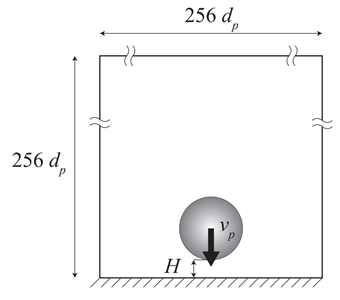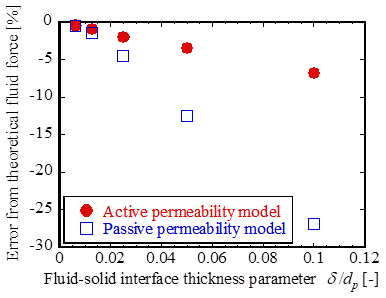Newsletter 2023.10 Index
Theme : "AJK FED 2023"
|
Determination of Permeability in the Volume Penalisation Method with a Smooth Mask Function
 Taichi TSUJIMOTO, Yuta NAKAO, Takuya TSUJI, Toshitsugu TANAKA, Kimiaki WASHINO Osaka University |
Abstract
Fluid-particle flows are frequently encountered in many engineering applications. However, our knowledge today about fluid-particle interactions is far from complete. The Volume Penalisation (VP) method is increasingly popular for Particle Resolved Direct Numerical Simulation (PR-DNS) where solid particles are modelled as permeable bodies with low permeability. In the VP method, fluid and solid (particle) are distinguished by a mask function. A smooth mask function with finite interface thickness is sometimes employed rather than a traditional sharp mask function to suppress numerical oscillation. In this case, however, the permeability should be determined with extra care otherwise the simulation results may become dependent on the interface thickness. In this work, a new model is proposed to determine the permeability in the VP method with a smooth mask function. It is “active” in the sense that the permeability is dependent on the flow field. The model is theoretically derived to reduce the model error particularly when the pressure gradient and/or external forces are large. The theory is based on the momentum equation simplified with the order-of-magnitude argument. Several test simulations of fluid-particle flows are performed to discuss the validity of the proposed model. In the simulation of a sphere moving towards a wall, the fluid force acting on the particle as well as the pressure increase at the particle-wall gap are accurately captured. In the simulation of suspension under simple shear, the relative viscosity is accurately estimated at high particle concentration. In addition, the proposed model is used to simulate complex fluid flow through packed ellipsoid and cuboid particles. It is found that the shape effect becomes more significant when the particle concentration is high.
Key words
Fluid-particle flow, Particle Resolved Direct Numerical Simulation (PR-DNS), Volume Penalisation method, Permeability
Figures

Figure 1. Schematic of a sphere moving towards a wall.

Figure 2. Error of fluid force acting on a particle.

Figure 3. (a) Flow through packed non-spherical particles and (b) non-spherical particles represented by superquadric function.

Figure 4. fluid force acting on the ellipsoid and cuboid particles.

